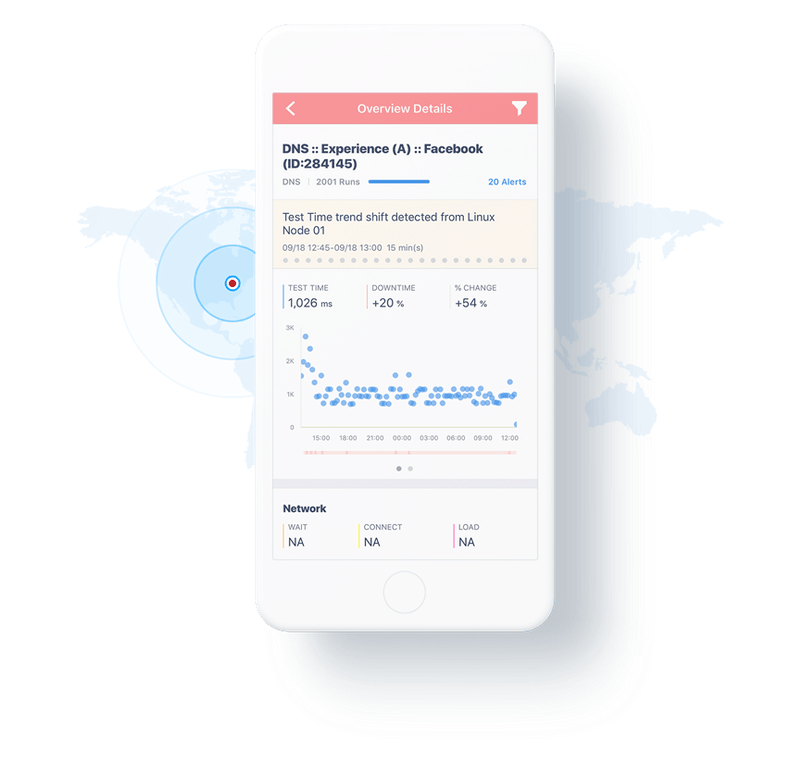When something on the Internet breaks, how do you fix it?
We make the Internet better, continuously revolutionizing how IT and enterprises use data to deliver business success.
When something on the Internet breaks, how do you fix it?
The answer depends, of course, on exactly what went wrong. But given that the Internet is a complex mashup of infrastructure, protocols and applications, identifying the root causes of failures can be difficult.
Catchpoint sheds light on the unknown. The company’s goal, in the words of VP of IT Operations Tony Ferrelli, is to save customers from having to “run a hodgepodge of tests” to understand user experience and application performance. With Catchpoint, businesses can proactively monitor their networks using data gained from real infrastructure and real networking stacks spread across the world.
Fixing the problems of the past
Catchpoint was founded in 2008 by a team of veterans from DoubleClick, an online advertising services company acquired by Google in 2007. One of the critical challenges that Catchpoint’s founders had lived through when working in the world of online advertising, according to Ferrelli, is that “ad serving needs to be done as quickly as possible -- ideally, within 200 milliseconds.” To do that, you need to be able to identify potential performance bottlenecks and solve them really quickly and comprehensively.
Engineers can tackle this problem by running a bunch of tests and trying to sort through the results manually. But doing so is “time-consuming and really frustrating for someone like me who had to deal with this on a day-to-day basis,” Ferrelli said. Understanding this problem, Catchpoint’s founders conceived the company’s platform as a solution “that fixes all the problems from the past.”
Catchpoint does that in part by providing synthetic monitoring, which allows businesses to test the reliability and performance of their software via simulated user requests. Because those requests are handled by real applications hosted on real infrastructure spread across the world, they reliably reproduce problems that might arise when deploying production services. In this way, Catchpoint helps businesses get ahead of network and application problems before they impact real users.
But that’s not all. Realizing that no amount of synthetic monitoring can guarantee flawless performance, Catchpoint also provides real-user monitoring. Real-user monitoring allows teams to identify and interpret performance or reliability problems that arise within actual production environments, then pinpoint their sources.
Catchpoint’s ability to develop cutting-edge monitoring solutions is informed, in part, by the company’s commitment to continuous improvement of its own software platform – an investment heralded by the company’s semi-annual hackathon, which aims to uncover bugs in Catchpoint’s code. The Catchpoint team doesn’t just sell monitoring solutions; it uses them internally, too.
A physical approach to monitoring and management
Catchpoint isn’t the only vendor in the business of synthetic network monitoring and management. What makes Catchpoint different, Ferrelli says, is its ability to test environments based on physical infrastructure distributed across the globe.
“We stand up nodes out in the wild and put them on a mix of ‘eyeball networks’ where users actually live,” Ferrelli says. “You can test applications where users actually are,” instead of testing them based on infrastructure that may or may not accurately mimic the networks on which real users depend. Today, Catchpoint has the largest number of global nodes in the industry, with close to 2000 global vantage points.
At the same time, Catchpoint supports highly granular, step-by-step analysis. “We can use networking protocols like ping and traceroute to narrow down networking issues and can mimic someone logging into a site, putting an item in a cart and clicking purchase, and we can then break down all the parts of the transaction” to find bottlenecks or pinpoint the source of performance problems, Ferrelli explained.
It's how we differentiate ourselves. Most other vendors use public cloud but Catchpoint makes extensive use of Equinix Metal servers to build out its global network testing infrastructure.
Cloud-like flexibility without compromise
In addition to delivering speed and scalability, running on physical servers gives Catchpoint full control over the networking stacks of its servers – something that public clouds cannot deliver, even for customers that use physical server instances in the public cloud.
That’s important, Ferrelli said, because Catchpoint’s customers need the ability to configure highly granular network settings to run accurate tests. They need to be able to specify which interconnect options to use, how to route traffic and so on, which you can only do when you have total control over your server and its environment.
To drive home the point, Ferrelli noted that Catchpoint’s customers can select from among 31 different ISPs across the eight colocation centers that the company uses. In the public cloud, they’d be limited to the handful of network carrier options that each cloud supports.
A new paradigm for digital experience management
Categorically speaking, testing and monitoring solutions like Catchpoint are not new.
But the company has found ways to stand apart from the crowd. It packs synthetic and real-user monitoring into a single package and makes them available through the largest number of physical node infrastructure in the world, giving customers total control over their environments, configurations and tests.

